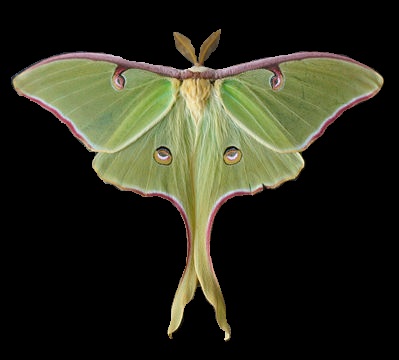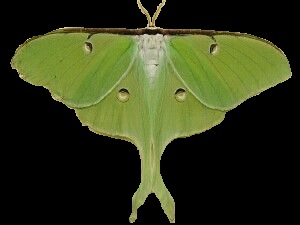Reproduction
Luna moths are dioecious (have
separate male and female organisms), can reproduce both sexually
and asexually, and specifically use a pheromone mating
system for sexual reproduction (Kumpulainen, et al., 2004). All females have a chemical that they release to attract
distant males. When ready to mate, the female moth stays
completely still for a few nights with unfertile eggs already in
her body. When she is ready, usually after midnight, she
releases the chemical form the tip of her abdomen by extending a
scent gland, almost like a wick.
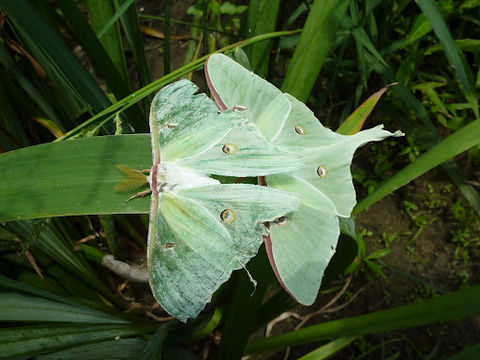 This chemical scent travels through the air, possibly reaching miles away. Male luna moths
fly in a zig-zag pattern until they pick up on a scent and track
down the female who is ready to mate. The female moth mates with
the first male that reaches her, almost like a "first come,
first serve" basis. Once the pair makes contact, they form a
copula. This copula must be undisturbed for about twenty-four
hours, otherwise the couple could separate and fertilization may
not be complete http://www.silkmoths.bizland.com). After the
full day of copulation, the male and female luna moth separate
and ovipositing begins and lasts for several nights. The female
finds a host plant to oviposit (deposit her eggs on).
This chemical scent travels through the air, possibly reaching miles away. Male luna moths
fly in a zig-zag pattern until they pick up on a scent and track
down the female who is ready to mate. The female moth mates with
the first male that reaches her, almost like a "first come,
first serve" basis. Once the pair makes contact, they form a
copula. This copula must be undisturbed for about twenty-four
hours, otherwise the couple could separate and fertilization may
not be complete http://www.silkmoths.bizland.com). After the
full day of copulation, the male and female luna moth separate
and ovipositing begins and lasts for several nights. The female
finds a host plant to oviposit (deposit her eggs on).
 Finding
the right host plant is very important because this is what the
caterpillar will be feeding on when
it hatches. Weirdly enough, the oviposit stage is when
fertilization of the eggs actually occurs, NOT copulation. When
the female is depositing her eggs on the plant leaves, the eggs
pass through a mix of sperm, "glue", and seminal fluids that are
stored in the female from when she was attached to the male.
Most females lay approximately two hundred and fifty eggs during
her seven to ten day adult life stage. Obviously all eggs are
not laid at the same time, and not even the same day. Eggs
deposited "x" amount of days before other eggs will end up
hatching "x" amount of days earlier. "The eggs are medium sized
and very dark brown in color" (wormspit.com).
Finding
the right host plant is very important because this is what the
caterpillar will be feeding on when
it hatches. Weirdly enough, the oviposit stage is when
fertilization of the eggs actually occurs, NOT copulation. When
the female is depositing her eggs on the plant leaves, the eggs
pass through a mix of sperm, "glue", and seminal fluids that are
stored in the female from when she was attached to the male.
Most females lay approximately two hundred and fifty eggs during
her seven to ten day adult life stage. Obviously all eggs are
not laid at the same time, and not even the same day. Eggs
deposited "x" amount of days before other eggs will end up
hatching "x" amount of days earlier. "The eggs are medium sized
and very dark brown in color" (wormspit.com).
Once these eggs hatch, they are
considered to be first instar caterpillars. There are five total
instar stages. Each time a caterpillar moves on to the next
instar, it has to molt (shed its old skin) to accommodate its
growing body.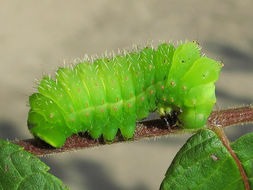 The first four instar stages last about three to seven days
each, and then the fifth and final instar lasts about six to
fourteen days.
Each instar stage has its own unique characteristics to tell how
old the caterpillar is. The second instar for example has very
prominent spiny tubercules. The fifth instar is characterized by
its very chubby appearance. The caterpillar has stored a very
large amount of food to last it through its cocoon stage. All
stages of caterpillar have a bright green colored body, hair like
projections, spiny tubercules, and a signature yellow stripe going along both
sides of its body. After the fifth instar, the caterpillar is
ready to spin its cocoon so it can transform into a green,
gorgeous luna moth (http://www.silkmoths.bizland). "The caterpillars spin their cocoons at the
base of the
The first four instar stages last about three to seven days
each, and then the fifth and final instar lasts about six to
fourteen days.
Each instar stage has its own unique characteristics to tell how
old the caterpillar is. The second instar for example has very
prominent spiny tubercules. The fifth instar is characterized by
its very chubby appearance. The caterpillar has stored a very
large amount of food to last it through its cocoon stage. All
stages of caterpillar have a bright green colored body, hair like
projections, spiny tubercules, and a signature yellow stripe going along both
sides of its body. After the fifth instar, the caterpillar is
ready to spin its cocoon so it can transform into a green,
gorgeous luna moth (http://www.silkmoths.bizland). "The caterpillars spin their cocoons at the
base of the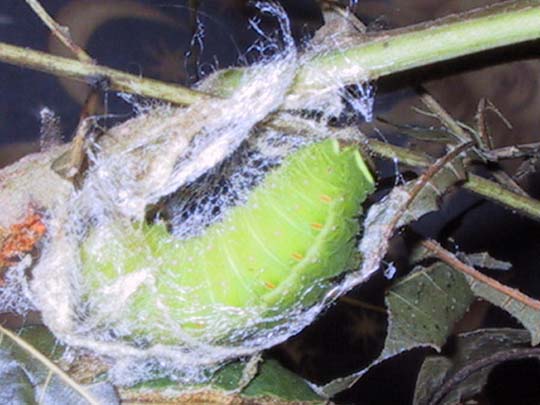 tree they were hatched on" (wormspit.com). This cocoon stage is the
only place silk is created in this organism's entire life, even
though it is considered to be in the silk moth family. There is
not nearly enough silk produced to be used for commercial
purposes!
tree they were hatched on" (wormspit.com). This cocoon stage is the
only place silk is created in this organism's entire life, even
though it is considered to be in the silk moth family. There is
not nearly enough silk produced to be used for commercial
purposes!
The life stages of a luna moth caterpillar and adult are so different, from reproduction, to eating habits, to what time of day they are most active. This insect is, by far, one of the most interesting to learn about in its family.
For more information on nutrition, click
here.
For more information on where you can find the luna moth, click
here.
To view the gallery, click here.
